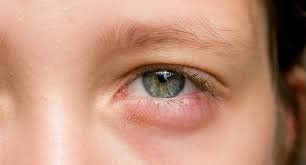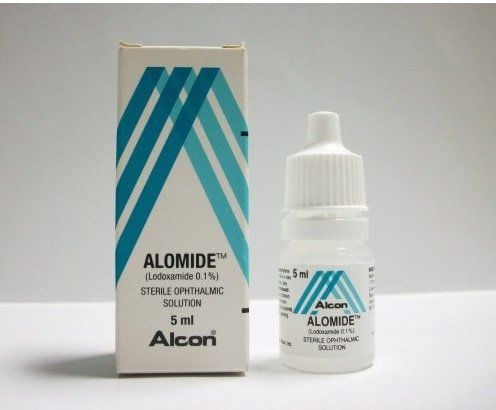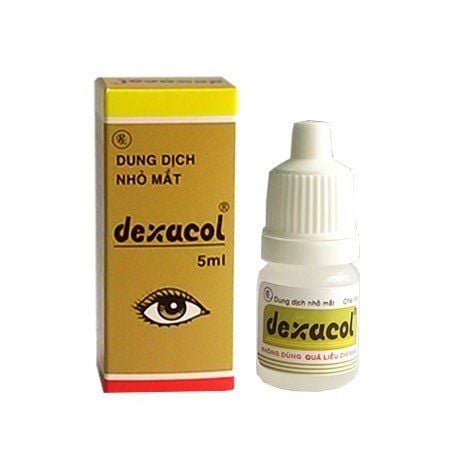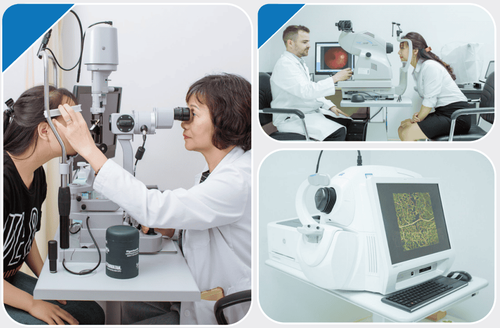This is an automatically translated article.
The article is professionally consulted by Master, Doctor Hoang Thanh Nga - Ophthalmologist - Department of Medical Examination and Internal Medicine - Vinmec Ha Long International General Hospital.
Conjunctivitis is a common disease that causes discomfort in the eyes and greatly affects daily activities. This is not a very dangerous disease, but if not treated in time, it can cause dangerous complications. The identification of types of conjunctivitis helps to prevent and treat the disease effectively.
1. What is conjunctivitis?
The conjunctiva is defined as a thin transparent membrane containing blood vessels, covering the sclera of the eyeball (the white) and the inner surface of the ciliary cartilage, forming two sacs with the upper and lower conjunctiva. When conjunctivitis is acute, the blood vessels at the conjunctival site become congested, causing the conjunctiva to edema and red, so people often call acute conjunctivitis pinkeye.
The disease can appear at all times of the year, but there are often epidemic outbreaks at times of change of season.
Acute conjunctivitis associated with serious pathologies such as:
Decreased visual acuity or light sensitivity due to persistent subepithelial infiltrates (inflamed cornea). Chronic lacrimation (excessive and frequent tearing) from problems caused by tear ducts. Decreased or loss of vision due to conjunctival retraction and partial or total adhesion of the conjunctiva (scarring of the conjunctiva).
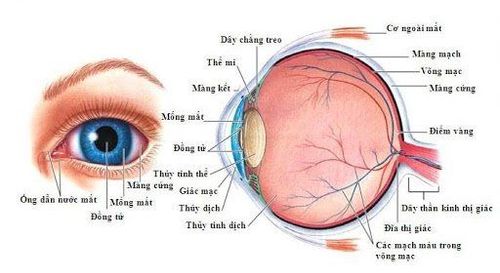
Vị trí của kết mạc mắt trên sơ đồ thiết ngang giải phẫu mắt
2. Types of eye conjunctivitis
2.1. Bacterial conjunctivitis Conjunctivitis caused by bacteria such as enterobacteriaceae, pneumococcus, staphylococcus aureus, meningococcal... Bacteria from dust, dirty tools, contaminated hands into the eyes or infection in other organs spread to the conjunctiva of the eye.
Typical disease symptoms:
Eye swelling such as grit, burning and many secretions leading to difficulty opening the eyes in the morning when waking up, appearing in one eye, then spreading to the second eye due to secretions spread to. Eyelids are swollen and scaly due to clinging secretions. The secretions are initially watery, similar to those found in viral infections, and then change to a purulent, mucoid form. The red conjunctiva is most prominent on the same map and fades as it reaches the margins. In severe cases, a pseudo-membrane may appear on the conjunctiva. The cornea is rarely infiltrated, although in severe cases superficial corneal dot and peritoneal gonorrhea may be seen.
2.2. Viral conjunctivitis Adenovirus conjunctivitis It is usually spread by direct contact with secretions from an infected person's eyes or through the respiratory tract and can be transmitted by sharing towels or sharing ophthalmic equipment. as an tonometer.

Người bị viêm kết mạc do virus có thể do sử dụng chung khăn mặt
Usually caused by virus types 3 and 7; Mild fever, sore throat and possibly swollen lymph nodes in front of the ears, fatigue; eyelid swelling and a feeling of heaviness; A feeling of clumps like sand in the eyes, then the eyes swell up quickly; Clear and sticky water secretion; The conjunctiva is bright red, edematous, sometimes hemorrhagic and appears many large granules arranged in rows in the same map; The cornea is less inflamed (about 30% of cases and is usually very mild). Conjunctivitis - keratitis
Caused by viruses of type 8 and 19 and rarely accompanied by systemic symptoms. Corneal manifestations are much more severe with 3 stages: Stage 1: Within 7 days after the onset of the disease: on the cornea, diffuse epithelial inflammation spots appear, usually after about 2 weeks. Stage 2: 1 week after the onset of the disease, manifested by temporary mottled keratitis, which may disappear completely after treatment. Stage 3: Appearing foci of corneal ossification as subepithelial spots. If left untreated, these foci of inflammation will persist for months or years, causing vision loss.
Herpes virus conjunctivitis: Usually appears in people who are infected with the herpes virus for the first time, manifesting on the skin of the eyelids and the skin around the eyelids, blisters appear, accompanied by red edema of the surrounding skin, secretions watery conjunctiva, ipsilateral conjunctival conjunctiva, with granulomatous reaction;
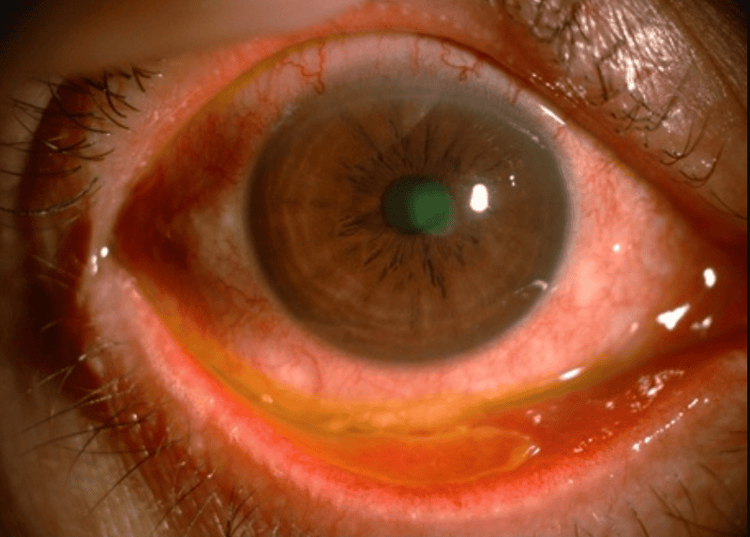
Hình ảnh viêm kết mạc do virus herpes
Allergic conjunctivitis Acute allergic conjunctivitis: The pathogenesis is an acute inflammatory response immediately after exposure to allergens. The eyelids and conjunctiva are sometimes frighteningly swollen, however, this usually lasts for several hours and is self-limiting.
Seasonal or year-round allergic conjunctivitis: Allergies are more severe with the seasons (usually spring or summer in temperate countries) or may appear year-round and are associated with allergic rhinitis.
Spring allergic conjunctivitis: This is a special disease, usually appears in boys aged 5-7 years, has a history of eczema, has a history of allergies in the family. This disease can damage the cornea, affecting vision.
Conjunctival allergy: Usually occurs in adults with a history of eczema or asthma. This type of allergic conjunctivitis presents year-round, in addition to the conjunctiva, causing damage to the eyelids (swelling, scabs, pterygium) and associated corneal vision loss.
Giant papillary allergic conjunctivitis: This is a disease caused by direct mechanical contact of the eyelid conjunctiva with foreign objects such as contact lenses, artificial eyes, sutures... in the eyelids can be seen on clinical examination.
Conjunctivitis caused by poisoning Acids, alkalis, toxic chemicals, atropine drugs are all strong irritants causing conjunctivitis, even vision loss, corneal damage.
Fungal conjunctivitis Fungal conjunctivitis is often accompanied by symptoms of corneal ulcers caused by Candida albicans, Aspergillus,...

Nấm Aspergillus là một trong các loại nấm gây tình trạng viêm kết mạc hiện nay
Parasites that cause conjunctivitis Conjunctivitis is caused by parasites such as lice. This is a clinically rare form of conjunctivitis.
Chlamydia conjunctivitis and keratitis in adults This is a sexually transmitted disease, rarely transmitted by eye-to-eye contact, mainly in young people and at least 50% of them are associated with infection. occult, asymptomatic genital tract bacteria. The disease appears subacute in one or both eyes and has purulent exudate, mild eyelid edema, purulent exudate, enlarged papillae in the upper eyelid cartilage conjunctiva, then forms very large granules mainly in the same area. lower eyelid, but also in the upper eyelid cartilage conjunctiva. The cornea is rarely affected, if present, it usually manifests as superficial punctate inflammation, sometimes subepithelial and periradicular infiltrates.
In case the disease persists, the granules will gradually decrease and be replaced by a smooth scar on the conjunctiva and a thin blood film on the cornea.
3. Distinguishing keratitis and conjunctivitis
3.1. About the cause The common point of both conjunctivitis and keratitis comes from 3 main causes: bacteria, viruses and allergies.
With conjunctivitis, the leading cause of conjunctivitis is mainly located in 3 main groups of agents: bacteria, viruses and allergies, and other diseases are quite rare. Of these, nearly 80% of viral conjunctivitis cases are caused by adenovirus. However, keratitis can also be caused by conditions such as arthritis, Sjogren's syndrome, or other metabolic disorders.
3.2. About symptoms Both conjunctivitis and keratitis share similar symptoms such as watery eyes, red eyes, and swollen eyelids.

Bệnh viêm giác mạc gây tình trạng đỏ mắt và sưng mí mắt ở người bệnh
However, if the causative agent is purely bacterial or pathological, keratitis will manifest in only one eye. Meanwhile, the most common sign of conjunctivitis is probably red eyeball and yellow discharge. There is also a feeling of lump in the eyes, itching of the eyelids and accompanied by some syndromes such as mild fever, lymphadenopathy, eyelid edema, pseudomembranous appearance... The disease can manifest in one or both eyes. and has many complications as well as different symptoms depending on the causative agent.
Vinmec International General Hospital with a system of modern facilities, medical equipment and a team of experts and doctors with many years of experience in neurological examination and treatment, patients can completely peace of mind for examination and treatment at the Hospital.
To register for examination and treatment at Vinmec International General Hospital, you can contact Vinmec Health System nationwide, or register online HERE.
SEE MORE
Conjunctivitis of the eye: Causes, symptoms, treatment and prevention Bacterial conjunctivitis should use what kind of eye drops? What to do when you have an allergic reaction to the skin around your eyes?




